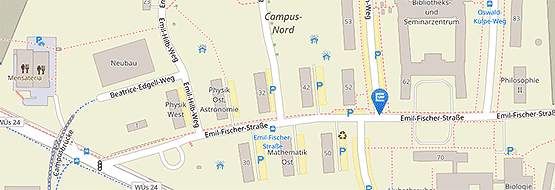Excellent Lecture on Small Fibre Neuropathy in the Long-term Course
11/04/2025Franka Kunik from the University Hospital of Würzburg receives the "Top Young Science" lecture award at the German Pain Congress. One finding of her work: prediabetes influences the development and progression of nerve damage.

In small fibre neuropathy (SFN), the very fine nerve fibres that are primarily responsible for the perception of pain and temperature are damaged. SFN typically manifests itself as burning pain, which usually occurs in the feet or hands, as well as sensations such as tingling.
Franka Kunik from Professor Nurcan Üçeyler's research group at the Neurological Clinic and Polyclinic of the University Hospital of Würzburg took a closer look at the long-term development of SFN. The working group examined 42 patients at the beginning of the study and again after an average of four years. In addition to detailed interviews and neurological examinations, various measurement methods were used to assess the small- and large-calibre nerve fibres. These included electrical nerve measurements, special pain and temperature sensation tests (quantitative sensory testing), examinations of the corneal nerves in the eye (corneal confocal microscopy) and the electrical conduction of the small fibres. In addition, small skin samples were taken from the legs to investigate skin innervation.
Over the Past Four Years, there has been no Significant Deterioration in Nerve Damage
Over the course of the study, almost half of the participants reported more severe or more widespread pain, while a good half noticed no change. Abnormal sensations such as tingling also occurred more frequently over time. In the tests of the small nerve fibres, on the other hand, the findings remained largely stable. There was only a slight deterioration in the sensitive testing in the sense of an increase in the perception thresholds for heat and cold. Overall, the results therefore indicate that although many patients develop more pain and discomfort over time, this deterioration is not reflected in a progression of the small fibre damage in the objective tests. In patients who only showed symptoms of small fibre damage from the outset, the electrophysiological examinations of the large calibre nerve fibres showed no evidence of involvement of these fibres, even over the course of the disease. There was therefore no progression to polyneuropathy over an average of four years.
"Small Fibre Neuropathy in the Long-term Course - Clinical Development and TRPV1 Expression on Intraepidermal Nerve Fibres"
"The protein content of the nerve endings in the skin also remained unchanged in patients with clinical deterioration compared to the initial findings," reports Franka Kunik. At the German Pain Congress, which took place from 22 to 25 October in Mannheim, the doctoral student provided insights into the immunohistochemical analysis of skin biopsies from affected patients. Both the results on "Small fibre neuropathy in the long-term course - clinical development and TRPV1 expression on intraepidermal nerve fibres" and the nature of the presentation impressed the jury, so that she received the "Top Young Science Symposium" lecture prize of 400 euros.
It remains unclear what pathophysiological role ion channels of the transient receptor potential family play in pain associated with SFN.
Prediabetes Influences the Development and Progression of Nerve Damage
However, the influence of prediabetes, i.e. a precursor of type 2 diabetes mellitus, on SFN became clearer. While the nerve damage in patients with idiopathic SFN (i.e. without any recognisable cause) did not deteriorate over a period of four years, the patients whose SFN was associated with prediabetes showed a further deterioration in nerve function over the course of the study. They also reported more frequent pain attacks.
Preventing Progression to Manifest Diabetes and Worsening Neuropathy with Diet and Exercise
"These results are of great importance for medical practice. They highlight the influence of prediabetes on the development and progression of nerve damage," says Nurcan Üçeyler. "Patients with prediabetes should be specifically informed about these risks. In such cases, doctors recommend a change in lifestyle, in particular a healthy diet and more exercise, as well as professional nutritional counselling to prevent the progression to manifest diabetes and thus also the worsening of neuropathy."
Franka Kunik would now like to investigate whether there is a connection between the worsening or new onset of prediabetes and the worsening of the clinical presentation of SFN. As part of the overarching project, the working group will advance the characterisation of nerve fibre endings in the skin using advanced analysis techniques and continue the search for possible starting points for more effective secondary prophylaxis.
The study is part of a project funded by the German Research Foundation (DFG) for the translational and multidimensional analysis of the mechanisms of nociceptor sensitisation in SFN. In this project, the clinical long-term development as well as cellular and molecular mechanisms of the small fibre disorder are being investigated.






